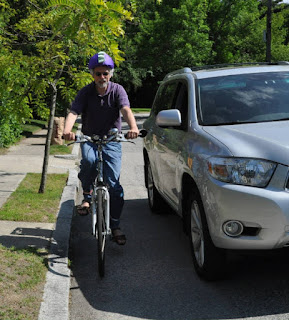In a coincidence that, perhaps, isn't such a coincidence, I chanced upon an item about an increase in the number of cyclists killed on Texas roads at the same time a local radio news program mentioned that pedestrian fatalities here in New York City have increased during the past year.
I have also seen and heard reports of increases in the number of cyclists killed and injured on New York City streets. So, hearing about pedestrian fatalities here and cyclists killed in the Lone Star State did not surprise me because cyclist and pedestrian casualties tend to rise or fall in tandem.
The reports point to a dramatic increase in the number of cyclists as a reason for more crashes and fatalities. The same isn't said for pedestrians, though I have seen more people walking around as pandemic-induced restrictions are eased or lifted. But I think that there is a related, and more relevant, reason for the increase in deaths and injuries among cyclists and pedestrians.
During the first few months of the pandemic, there was little traffic on the roads. I can recall riding to Connecticut and back last spring and being able to count, on both hands, the number of motorized vehicles I saw along the way, not counting the ones that crossed the RFK Memorial Bridge. Until last spring, I never could have imagined such an occurence on a 140 kilometer road ride that takes me through the Bronx and Westchester County before crossing the state line.
As spring turned into summer, traffic was still light, but I noticed faster and more aggressive driving, including some drag racing and other flouting of traffic laws. Those things were annoying, but I didn't feel I was in danger because the still-light traffic afforded a wide berth between me and the drivers.
During the past few months, though, I've seen more traffic. Some people, I guess, are returning to their workplaces and old routines, while others started driving and bought cars (for the first time, in some instances) because they didn't want to use mass transit.
But the folks who got used to driving fast and aggressively, or even carelessly, aren't adjusting to the new reality. They still want to drive as if they have the streets to themselves. And, in my own unscientific observation, it seems that police aren't enforcing traffic laws as much as they were before the pandemic--if, indeed, they were enforcing them against any but the lowest-hanging fruit (i.e., cyclists and pedestrians).
Having done a fair amount of cycling in other cities, states and countries, I can make this observation: Building bike lanes and lecturing cyclists about safety--which most of us practice to the best degree we can--does little to prevent tragic encounters between motorists and cyclists and pedestrians.
What will make life better for everyone involved are sensible laws and policies (like the Idaho Stop) crafted by people who understand what it's like to ride a city's streets--and a culture rather than a mere lifestyle of cycling. The culture of which I speak is one in which cycling is seen as a viable mode of transportation rather than just a form of recreation for privileged young people. Such a culture exists in some European countries; that is why there is more respect between drivers and cyclists and pedestrians.
Otherwise, cities and other jurisdictions can continue to build poorly-designed and constructed bike lanes that lead from nowhere to nowhere, and cyclists--or pedestrians or motorists--won't be any safer.

